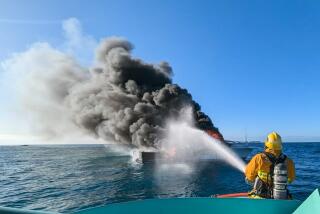Sneak Previews of Forthcoming Books of Special Interest to Southern Californias : Lost at Sea : ‘With a tent fly, a poncho and two sarongs, they fashioned a sail, and they pointed their vessel toward Sumatra.’
- Share via
The following is from “Islands of Fire, Islands of Spice,” by Richard Bangs and Christian Kallen, published this month by Sierra Club Books.
IN LATE AUGUST, 1985, two 27-year-old Southern Californians, Rickey Berkowitz and Judy Schwartz, took a boat trip to Krakatau. The seas were calm, and the journey was made out and back in a day without incident. But then they decided to visit Ujung Kulon, a national park and wildlife refuge on the remote southwestern tip of Java. Lushly enveloped in a thick mantle of jungle, it is the last refuge for the one-horned Javan rhinoceros, and it hosts good numbers of wild oxen, leopards, panthers, pythons, tigers, mouse deer, boar and bats.
The only way to get to Ujung Kulon is by boat. Though Berkowitz and Schwartz had requested a “big” boat for the nine-hour trip, they ended up with a four-meter fiberglass runabout, piloted by two non-English-speaking Indonesians. Just 16 kilometers from their destination, the boat’s engine quit. There were no oars or paddles, no sail or rudder, no emergency equipment. They were adrift in the shark-infested waters of the Sunda Strait, the channel between Java and Sumatra that links the Indian Ocean and the Java sea.
After the first night at sea, the boat drifted past Ujung Kulon; by the third day they had lost sight of land altogether. The women had brought food and water for several days, so they weren’t worried. They had registered their trip with the Park Service. But the seventh day came and went without a ship on the horizon or a plane in the sky. With a tent fly, a rain poncho and two sarongs they fashioned a crude sail, and they pointed their vessel toward Sumatra.
By the beginning of the second week the girls’ parents had flown to Indonesia, and a full-scale aerial and water search was being coordinated. The village of the two Indonesian boatmen went into mourning. According to local belief, every year Nyai Loro Kidul, goddess of the South Sea, demands a human sacrifice. One of the American women had worn a green T-shirt that was the same fatal green favored by the goddess, and some villagers speculated that the Americans were agents for Nyai Loro Kidul.
In the second week, a rift grew between the Indonesian men and the American women. The Americans had tried to ration food and water by dividing it among the four of them. But the Indonesians, who had been brought up in the affluence of a fertile, tropical coastline, couldn’t grasp the concept and wolfed down their share as they got hungry. Then at night they stole from their companions. The only sustenance the women could keep from their boat mates was a small tube of toothpaste, to which they treated themselves a finger smear each evening in what they called their “happy hour.”
On day 10, one of the Indonesians went berserk and with a machete started chopping at the boat and finally stopped when Schwartz offered him her last three peanuts.
It would be another 10 days before they sighted land, the southwestern shore of Sumatra. Finally, in the middle of their 21st night at sea, a wave picked up their beaten boat and smashed it against a Sumatran coral reef. All four were washed to shore, where the next morning some lobster fishermen escorted them to the closest village for a feast of shellfish and hot rice. Within a week, the two Americans were back home appearing on talk shows, while the two Indonesians were confined to a hospital where the police kept grilling them in the belief they were drug smugglers. Three weeks adrift in an open boat with two American women just seemed too preposterous. And it still does.
Copyright 1988 by Richard Bangs and Christian Kallen.
More to Read
Sign up for our Book Club newsletter
Get the latest news, events and more from the Los Angeles Times Book Club, and help us get L.A. reading and talking.
You may occasionally receive promotional content from the Los Angeles Times.










